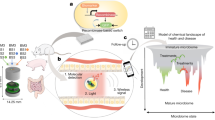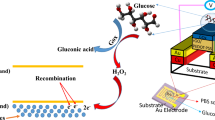Abstract
There exists a strong correlation between the pH levels of the gastrointestinal (GI) tract and GI diseases such as inflammatory bowel disease (IBS), ulcerative colitis, and pancreatis. Existing methods for diagnosing many GI diseases predominantly rely on invasive, expensive, and time-consuming techniques such as colonoscopy and endoscopy. In this study, an autonomous ingestible smart biosensing system in a pill format with integrated pH sensors is reported. The smart sensing pills will measure the pH profile as they transit through the GI tract. The data is then downloaded from the pills after they are collected from the feces. The sensor is based on electrodeposited PANI on carbon-coated conductive threads providing high pH sensitivity. Engineering innovations allowed integration of thread-based sensors on 3D-printed pill surfaces with front-end readout electronics, memory, and microcontroller assembled on mm-size circular printed circuit boards. The entire smart sensing pill possesses an overall length of 22.1 mm and an outer diameter of 9 mm. The modular biosensing system allows integration of thread-based biosensors to monitor other biomarkers in GI tract that mitigates the complex sensor fabrication process as well as overall pill assembly.






Similar content being viewed by others
Abbreviations
- PCB::
-
Printed circuit board
- FIR::
-
Finite-impulse response
- DSP::
-
Digital signal processing
- FTIR::
-
Fourier-transform infrared
- PANI::
-
Polyaniline
- GI::
-
Gastrointestinal
- IBS::
-
Inflammatory bowel disease
- GERD::
-
Gastroesophageal reflux disease
- ISFET::
-
Ion-sensitive field-effect transistor
- IPA::
-
Isopropyl alcohol
- PU::
-
Polyurethane
- CC::
-
Carbon-coated
- PVB::
-
Polyvinyl butyral
- WE::
-
Working electrode
- RE::
-
Reference electrode
- CE::
-
Counter electrode
- CV::
-
Cyclic voltammetry
- OCV::
-
Open-circuit voltage
- EEPROM::
-
Electrically-erasable programmable read-only memory
- SPI::
-
Serial peripheral interface
- ADC::
-
Analog to digital converter
- NMOS::
-
N-type metal oxide semiconductor
- PMOS::
-
P-type metal oxide semiconductor
- SLA::
-
Stereolithography
- FDA :
-
Food and drug administration
- SEM::
-
Scanning electron microscope
- EB::
-
Emeraldine base
- ES::
-
Emeraldine salt
- LE::
-
Leucoemeraldine
References
Fallingborg J (1999) Intraluminal pH of the human gastrointestinal tract. Dan Med Bull 46(3):183–196
Press AG, Hauptmann IA, Hauptmann L et al (1998) Gastrointestinal pH profiles in patients with inflammatory bowel disease. Alimentary Pharmacology & Therapeutics 12(7):673–678. https://doi.org/10.1046/j.1365-2036.1998.00358.x
Kalantar-Zadeh K, Ha N, Ou JZ et al (2017) Ingestible sensors. ACS Sens 2(4):468–483. https://doi.org/10.1021/acssensors.7b00045
Steiger C, Abramson A, Nadeau P et al (2019) Ingestible electronics for diagnostics and therapy. Nat Rev Mater 4:83–98. https://doi.org/10.1038/s41578-018-0070-3
Min J, Yang Y, Wu Z et al (2020) Robotics in the gut. Advanced Therapeutics 3(4):1900125. https://doi.org/10.1002/adtp.201900125
Onuki Y, Bhardwaj U, Papadimitrakopoulos F et al (2008) A review of the biocompatibility of implantable devices: current challenges to overcome foreign body response. J Diabetes Sci Technol 2(6):1003–15. https://doi.org/10.1177/193229680800200610
Gonzalez-Guillaumin JL, Sadowski DC, Kaler KVIS et al (2007) Ingestible capsule for impedance and pH monitoring in the esophagus. IEEE Trans Biomed Eng 54(12):2231–2236. https://doi.org/10.1109/TBME.2007.908332
Kalantar-zadeh K, Yao CK, Berean KJ et al (2016) Intestinal gas capsules: a proof-of-concept demonstration. Gastroenterology 150(1):37–39. https://doi.org/10.1053/j.gastro.2015.07.072
Nadeau P, El-Damak D, Glettig D et al (2017) Prolonged energy harvesting for ingestible devices. Nature Biomedical Engineering 1(0022). https://doi.org/10.1038/s41551-016-0022
Mimee M, Nadeau P, Hayward A et al (2018) Prolonged energy harvesting for ingestible devices. Nature Biomedical Engineering 360(6391):915–918. https://doi.org/10.1126/science.aas9315
Cao H, Landge V, Tata U et al (2012) An implantable, batteryless, and wireless capsule with integrated impedance and pH sensors for gastroesophageal reflux monitoring. IEEE Trans Biomed Eng 59(11):3131–3139. https://doi.org/10.1109/TBME.2012.2214773
Zhou L, Cheng C, Li X et al (2020) Nanochannel templated iridium oxide nanostructures for wide-range pH sensing from solutions to human skin surface. Anal Chem 92(5):3844–3851. https://doi.org/10.1021/acs.analchem.9b05289
Cheng C, Wu Y, Li X et al (2021) A wireless, ingestible pH sensing capsule system based on iridium oxide for monitoring gastrointestinal health. Sensors and Actuators B: Chemical 349:130781. https://doi.org/10.1016/j.snb.2021.130781
Arefin MS, Redouté JM, Yuce MR (2018) Integration of low-power ASIC and MEMS sensors for monitoring gastrointestinal tract using a wireless capsule system. IEEE Journal of Biomedical and Health Informatics 22(1):87–97. https://doi.org/10.1109/JBHI.2017.2690965
Rajan TS, Read TL, Abdalla A et al (2020) Ex vivo electrochemical pH mapping of the gastrointestinal tract in the absence and presence of pharmacological agents. ACS Sensors 5(9):2858–2865. https://doi.org/10.1021/acssensors.0c01020
Xu F, Yan G, Wang Z et al (2015) Continuous accurate pH measurements of human GI tract using a digital pH-ISFET sensor inside a wireless capsule. Measurement 64:49–56. https://doi.org/10.1016/j.measurement.2014.12.044
Ges IA, Ivanov BL, Schaffer DK et al (2005) Thin-film IrOx pH microelectrode for microfluidic-based microsystems. Biosens Bioelectron 21(2):248–256. https://doi.org/10.1016/j.bios.2004.09.021
Manjakkal L, Szwagierczak D, Dahiya R (2020) Metal oxides based electrochemical pH sensors: current progress and future perspectives. Prog Mater Sci 109. https://doi.org/10.1016/j.pmatsci.2019.100635
Mostafalu P, Akbari M, Alberti K et al (2016) A toolkit of thread-based microfluidics, sensors, and electronics for 3D tissue embedding for medical diagnostics. Microsyst Nanoeng 2(16039). https://doi.org/10.1038/micronano.2016.39
Lyu B, Punjiya M, Matharu Z et al (2018) An improved pH mapping bandage with thread-based sensors for chronic wound monitoring. In: 2018 IEEE International Symposium on Circuits and Systems (ISCAS), pp 1–4. https://doi.org/10.1109/ISCAS.2018.8351878
Terse-Thakoor T, Punjiya M, Matharu Z et al (2020) Thread-based multiplexed sensor patch for real-time sweat monitoring. npj Flex Electron 4(18). https://doi.org/10.1038/s41528-020-00081-w
Xia J, Khaliliazar S, Hamedi M et al (2021) Thread-based wearable devices. MRS Bulletin 46:502–511. https://doi.org/10.1557/s43577-021-00116-1
Asci C, Del-Rio-Ruiz R, Sharma A et al (2022) Ingestible pH sensing capsule with thread-based electrochemical sensors. In: 2022 IEEE Sensors, pp 1–4. https://doi.org/10.1109/SENSORS52175.2022.9967347
Xia J, Sonkusale S (2021) Flexible thread-based electrochemical sensors for oxygen monitoring. Analyst 146:2983–2990. https://doi.org/10.1039/D0AN02400G
Glass P, Cheung E, Sitti M (2008) A legged anchoring mechanism for capsule endoscopes using micropatterned adhesives. IEEE Trans Biomed Eng 55(12):2759–2767. https://doi.org/10.1109/TBME.2008.2002111
Basar MR, Ahmad MY, Cho J et al (2018) An improved wearable resonant wireless power transfer system for biomedical capsule endoscope. IEEE Trans Ind Electron 65(10):7772–7781. https://doi.org/10.1109/TIE.2018.2801781
Punjiya M, Nejad HR, Mostafalu P et al (2017) pH sensing threads with CMOS readout for smart bandages. In: 2017 IEEE International Symposium on Circuits and Systems (ISCAS), pp 1–4. https://doi.org/10.1109/ISCAS.2017.8050730
Mostafalu P, Tamayol A, Rahimi R et al (2018) Smart bandage for monitoring and treatment of chronic wounds. Small 14(33):1703509. https://doi.org/10.1002/smll.201703509
Smith RE, Totti S, Velliou E et al (2019) Development of a novel highly conductive and flexible cotton yarn for wearable pH sensor technology. Sensors and Actuators B: Chemical 287:338–345. https://doi.org/10.1016/j.snb.2019.01.088
Mazzara F, Patella B, D’Agostino C et al (2021) PANI-based wearable electrochemical sensor for pH sweat monitoring. Chemosensors 9(7). https://doi.org/10.3390/chemosensors9070169
Huang YY, Wu J (2022) Preparation and characterization of graphene oxide/polyaniline/carbonyl iron nanocomposites. Materials (Basel) 15(2). https://doi.org/10.3390/ma15020484
Duan W, Ronen A, Walker S et al (2016) Polyaniline-coated carbon nanotube ultrafiltration membranes: enhanced anodic stability for in situ cleaning and electro-oxidation processes. ACS Appl Mater Interfaces 8(34):22574–22584. https://doi.org/10.1021/acsami.6b07196
Pan W, Chen Q (2022) Preparation and electroactuation of water-based polyurethane-based polyaniline conductive composites. e-Polymers 22(1):182–189. https://doi.org/10.1515/epoly-2022-0005
Fleischer M, Meixner H (1992) Sensing reducing gases at high temperatures using long-term stable Ga2O3 thin films. Sensors and Actuators B: Chemical 6(1):257–261. https://doi.org/10.1016/0925-4005(92)80065-6
Li Y, Mao Y, Xiao C et al (2020) Flexible pH sensor based on a conductive PANI membrane for pH monitoring. RSC Adv 10:21–28. https://doi.org/10.1039/C9RA09188B
Ge C, Armstrong N, Saavedra SS (2007) pH-sensing properties of poly(aniline)ultrathin films self-assembled on indium-tin oxide. Anal Chem 79(4):1401–1410. https://doi.org/10.1021/ac061740e
Stack BH (1969) Use of the Heidelberg pH capsule in the routine assessment of gastric acid secretion. Gut 10:245–246. https://doi.org/10.1136/gut.10.3.245
Kwiatek M, Pandolfino J (2008) The BravoTM pH capsule system. Dig Liver Dis 40(3):156–160. https://doi.org/10.1016/j.dld.2007.10.025
Zhao K, Yan G, Lu L et al (2015) Low-power wireless electronic capsule for long-term gastrointestinal monitoring. J Med Syst 39(9). https://doi.org/10.1007/s10916-015-0211-9
Jiang H, Yu W, Oscai M et al (2018) A smart capsule with a hydrogel-based pH-triggered release switch for GI-tract site-specific drug delivery. IEEE Trans Biomed Eng 65(12):2808–2813. https://doi.org/10.1109/TBME.2018.2818463
De la Paz E, Maganti NH, Trifonov A et al (2022) A self-powered ingestible wireless biosensing system for real-time in situ monitoring of gastrointestinal tract metabolites. Nat Commun 13(1). https://doi.org/10.1038/s41467-022-35074-y
Gopalakrishnan S, Thomas R, Sedaghat S et al (2023) Smart capsule for monitoring inflammation profile throughout the gastrointestinal tract. Biosensors and Bioelectronics: X 14:100380. https://doi.org/10.1016/j.biosx.2023.100380
Acknowledgements
We acknowledge the support of the National Institute of Health (NIH) under the grant R21AI144521 and R21DK132314. S. Sonkusale would also like to acknowledge DoD DURIP and Massachusetts Life Sciences Center (MLSC) for equipment support.
Author information
Authors and Affiliations
Corresponding author
Ethics declarations
Conflict of interest
The authors declare no competing interests.
Supplementary Information
Below is the link to the electronic supplementary material.
Rights and permissions
Springer Nature or its licensor (e.g. a society or other partner) holds exclusive rights to this article under a publishing agreement with the author(s) or other rightsholder(s); author self-archiving of the accepted manuscript version of this article is solely governed by the terms of such publishing agreement and applicable law.
About this article
Cite this article
Asci, C., Sharma, A., Del-Rio-Ruiz, R. et al. Ingestible pH sensing device for gastrointestinal health monitoring based on thread-based electrochemical sensors. Microchim Acta 190, 385 (2023). https://doi.org/10.1007/s00604-023-05946-1
Received:
Accepted:
Published:
DOI: https://doi.org/10.1007/s00604-023-05946-1




